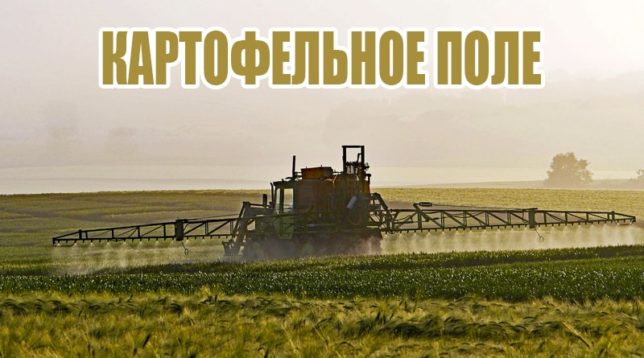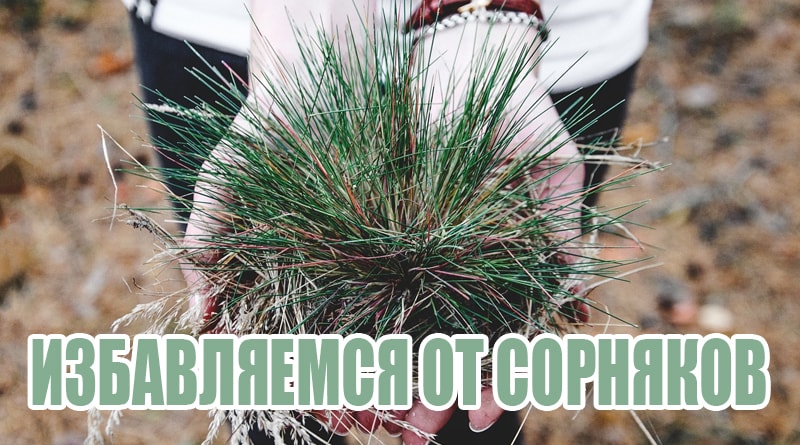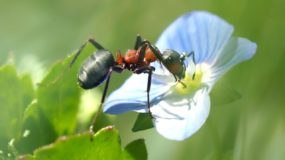Each avid summer resident eagerly sees off the last winter days, and awaits the arrival of spring and warmth with trepidation. But the joy of the upcoming garden work is overshadowed by memories of the endless weed control. How to emerge victorious in this unequal battle?
Weeds have a powerful root system that "knows how" adapts to any weather conditions, so weed grass grows so quickly and intensively throughout the site. It seems that it is impossible to overcome it.
Safety Precautions
To effectively control weeds, it is often necessary to use chemicals, therefore, in the process, basic precautions must be observed:
- To protect the body, use long-sleeved clothing, safety glasses, and gloves.
- To protect the oral cavity, use a respirator or mask of several layers of gauze.
- After finishing work with chemicals, wash thoroughly and change clothes.
During work, it is necessary to observe not only personal safety measures, but also take care of the environment:
- Do not allow chemicals to enter the nearest body of water.
- Processing in the evening to avoid mass death of bees.
- Block access for animals and children to the cultivated area.
Effective folk weed control methods

Often, gardeners choose safe folk methods to destroy weeds. There are no single recommendations, everyone chooses an acceptable option.
Soda
It helps to cope with the problem at the summer cottage baking soda. It is enough to prepare a thick solution and carefully process the plants. The effect will not keep you waiting long - the weeds will gradually weaken and die.
Soap solution
One option would be to prepare a soap-based solution damaging to weed grass. This will require:
- Vinegar.
- Salt.
- Grated laundry soap.
Mix the ingredients in equal proportions and spray evenly throughout the area.
Salt
In the fight against harmful vegetation, ordinary table salt comes to the rescue of the summer resident. It is used both in dry form and diluted in warm water. Both of these methods are good.
Salt to process paths, courtyard and those areas that are not used for planting cultivated plants.
- Salt is scattered around the site at the rate of 1.5 kg of salt per 1 m². Make it better before the rain. The crystals will dissolve and penetrate the soil.
- A concentrated salt solution is sprayed with a spray gun.
Gasoline and kerosene
Some summer residents consider kerosene to be a good way to remove weed grass in beds with carrots and dill. It is harmful to weeds, but carrots will not suffer. Processing is carried out when the first leaves of culture appear, at the rate of 100 grams of kerosene per 1 m².
Perhaps the use of gasoline. However, during use, extreme care should be taken and safety precautions must be followed when handling flammable products.
Vinegar
To prepare an effective solution, you will need water and vinegar in equal proportions. The site is treated with a spray in calm, warm weather. Getting on the leaves and stems of weeds, an acetic solution affects them and contributes to the complete destruction.
The method will help before flowering, prevent the ripening of seeds.
Ethyl alcohol and vodka
A month before the start of sowing, you can use a solution containing alcohol. To do this, 95% ethanol is diluted with water in a ratio of 1:10 and cultivated by land.
Specialized Chemistry
Often there are so many weeds that one can not do with folk remedies and weeding alone. And it is impossible to get rid of plants with a powerful root system, even if you deeply plow the ground and manually select everything. In difficult cases, herbicides will come to the rescue of the summer resident. “Tornado”, “Zero”, “Glyph”, “Sniper”, “Roundup”, “Hurricane forte” and many other very effective means.
Herbicides have several advantages and stand out among other drugs:
- Facilitate manual labor.
- The duration of the action does not depend on weather conditions.
- Quickly and effectively destroy weeds.
Herbicides also have a number of disadvantages:
- When sprayed, toxic to animals and insects.
- Poor effect on perennial plants.
- They act selectively.
- Chemical-sensitive crop plants easily cause stress.
- Ari repeated use in weeds develops resistance to a particular drug.
Herbicides
Using herbicides is one of the most effective weed control methods. There are two types of drugs that differ in spectrum of action:
- Selective herbicides. Aimed at the destruction of one species of weed, but useless for others.
- Continuous herbicides. Getting on the leaves of weeds, contribute to their drying within three weeks after treatment.
The use of herbicides is an excellent option for treating a lawn before sowing grass or beds before planting seedlings. They are effective in neglected areas.
Sideral plants
You can also get rid of unnecessary vegetation in the summer cottage with the help of green manure. These are plants that are planted for a short period. Then they are mowed and used as mulch for soil or for filling compost pits.
Landing on the country side of green manure helps in solving a number of problems:
- It inhibits the growth and development of weeds, prevents their growth,
- Promotes loosening of the soil and its intensive enrichment with oxygen,
- It optimizes the acidity of the soil.
Sowing rye, mustard (the most famous siderates) can be carried out at any time of the year, with no additional fertilizers needed. Any unrelated annual plant with a powerful root system is suitable as a sideral culture.
Effective microorganisms
The use of various drugs based on effective microorganisms is an innovative technology in agronomy. They are used in the fight against weeds, excluding plowing the soil.
Microorganisms entering the soil ensure its fertility and preserve the ecology of the environment. The main advantages of their use:
- Efficiency.
- Low cost.
- Agroecological method.
Mechanical impact

Mechanical control measures are aimed at the depletion, removal, freezing of weeds.
These include:
- Harrowing.
- Cultivation.
- Mulching.
- Plowing.
- Weeding.
The result of mechanical control methods depends on the timeliness and quality of the operation.
Weeding
One of the traditional ways of controlling weeds that has been tested for centuries is manual weeding, which helps permanently destroy the problem on small land plots. Often, to facilitate manual work, use a sickle or hoe.
It is easiest to weed immediately after rain or thorough watering.Weeds can easily be taken out from the moist earth along with the roots without damaging the cultivated plants.
Mulching
One of the most effective weed control methods is to mulch the soil. Sawdust, dry grass, straw and other materials are often used as mulch. Mulch unfolds on the surface of the soil.
- Promotes long-term preservation of moisture.
- Protects the roots of cultivated plants from frost.
- Optimizes the acidity of the soil and improves its structure.
- Suppresses weeds.
- Protects plants from pests.
- Protects a crop from decay.
Features of weed removal from different places
The use of certain methods can be effective in some areas, but useless in others. What measures to take in various conditions to forget about “annoying neighbors” forever?
Country cottage area
We will have to make a lot of efforts to make the summer cottage look well-groomed all season.
The most effective way to destroy weeds is to manually remove the roots from the ground - timely weeding of the entire site. Removing perennials and preventing their flowering will also help in the fight against weed grass. The combined use of chemical and mechanical methods of control will give a positive result.
Lawn
Before forming a lawn and planting cultivated plants on it, thorough soil preparation is required. These measures will prevent weed spread and reduce the number of weeds per season.
To get rid of annuals on the lawn is quite simple, just remove the entire root system from the ground. If they nevertheless sprouted, it is necessary to weed more often, and to prevent the formation of seeds. If the flowers do not grow on the lawn, you can use the usual mowing. From the first time, weeds will weaken, and subsequent ones will forget about them forever.
Mowing the lawn is useless in the fight against creeping weeds. To get rid of them forever requires complete suppression of the root system.
Potato field

Weed control on potatoes is carried out in various ways:
- Crop rotation.
- Presowing treatment.
- Mechanical tillage.
- Use of herbicides.
Herbicides, which include hizalofop-P-ethyl, perfectly cope with annual and perennial cereal weeds in potatoes, soybeans, rape. However, they have no phytotoxic effect on subsequent plantings on related crops.
The use of glyphosphate-containing herbicides with mechanical processing of the land performed a week before the potato seedlings is also effective for weed control. When making the drug, it is necessary to take into account the peculiarity of the soil and adjust the norm.
The use of pure steam in crop rotation also helps reduce weed growth.
Cemetery
For the destruction of weeds in the cemetery, any continuous glyphosphate-based herbicides are suitable. The solution is prepared according to the instructions on the package. Processing is carried out in such a way that the solution falls on the leaves and stems of plants. Within 1–2 weeks after treatment, the plants die completely.
A reinforced dose of the herbicide will even get rid of small shrubs. However, to enhance the effect, it is necessary to process the neighboring area.
Flowerbeds and greenhouses
Effective ways to control weeds in the flower beds are:
- Mulching the soil.
- Use of agrofibre.
- Planting of decorative ground cover plants.
- Removing young weeds.
Herbicides of systemic action are used with great care, trying not to touch cultivated plants when processing.
Is it possible to get rid of weeds forever
It’s unlikely to get rid of annoying weeds forever, because they grow not only in your area and can grow over a long distance. But the application on an ongoing basis of different methods will allow you to qualitatively confront the problem.
Video instruction
Common weed species in a summer cottage and garden
Perennial and annual weeds quickly appear and grow in summer cottages. Some types, methods of their distribution and effective measures to combat them are given in the table.
Examples of common weeds, their life cycles and methods of reproduction
| Title | Life cycle | Distribution method | Methods of struggle |
|---|---|---|---|
| Field bindweed | Perennial | The roots |
|
| Mokritsa | Annual | Seeds |
|
| Nettle | Perennial | The roots |
|
| Quinoa | Annual | Seeds |
|
| Dandelion | Perennial | Seeds |
|
| Wheat grass creeping | Perennial | Rhizome |
|
| Cirsium field | Perennial | The roots |
|
| Bonfire | Annual | Seeds |
|
Useful Tips
An effective and safe weed control can be done at home. To do this, you need 400 ml of white vinegar, 2 tbsp. tablespoons of citric acid, 30 ml of alcohol and 2 teaspoons of dishwashing detergent. Dilute the resulting solution with water in equal proportions and treat the weeds with a spray.
The universal siderates that prevent the growth of weeds are the composition of rapeseed, oilseed radish and white mustard taken in equal proportions. The plot is sown at the rate of 200 grams of seeds per one hundred square meters of land. The growth of these herbs not only contributes to the destruction of weeds, but also increases the fertility of the soil.










